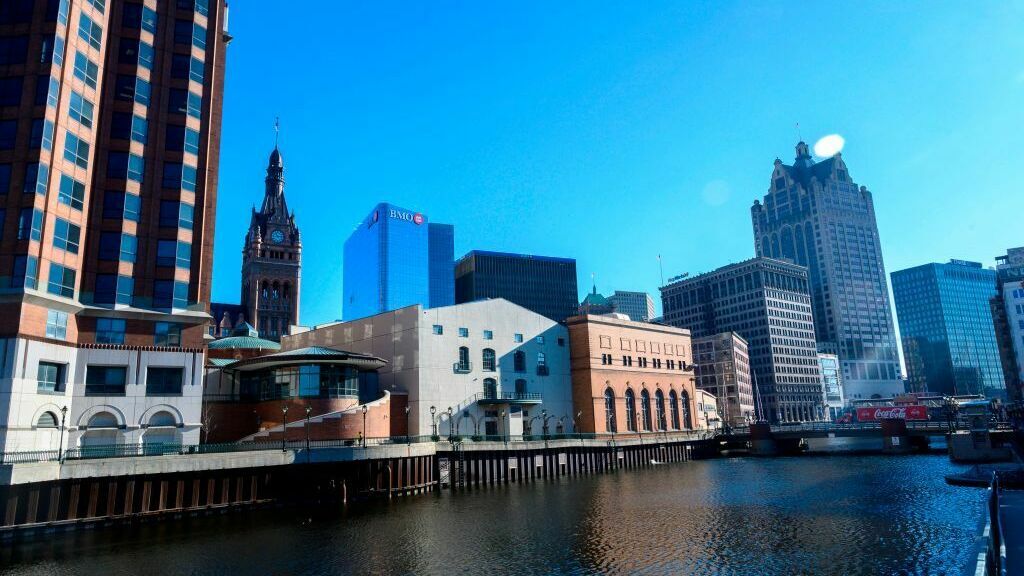The City Hall tower is seen in January 2020 in downtown Milwaukee, Wis.
Eric Baradat/AFP via Getty Images
Hide title
Change the title
Eric Baradat/AFP via Getty Images

The City Hall tower is seen in January 2020 in downtown Milwaukee, Wis.
Eric Baradat/AFP via Getty Images
The Republican National Committee and Fox News Channel will host the first official showcase event for Republican candidates in the 2024 presidential cycle on Wednesday in Milwaukee, which is set to host the GOP’s national nominating convention next July.
Milwaukee has previously been a debating ground for both parties. The Wisconsin city on the shores of Lake Michigan was one of a dozen GOP debate sites where Republicans last did this eight years ago.
But the city’s selection for the GOP’s national nominating convention, its premier quadrennial event, raised eyebrows.
Does it make sense to hold the party’s primary event on such a fundamentally democratic terrain? Aren’t the Democrats thinking of holding their convention there too?
To take the second question first, the Democrats were They plan to hold their conference in Milwaukee in 2020. Then came Covid, causing confusion in both parties’ conference plans. Democrats still held few official events in Milwaukee, but continued their media extravaganza on television and the Internet from various locations around the country.

Then in August of last year, the RNC announced Milwaukee as the site for the GOP convention in 2024. That’s it. They’ll hold the shindig at Fiserve Forum, where the Milwaukee Bucks play, and hold their first intramural debate there.
It repeated the pattern of the last GOP contested primary before the 2016 election. At that time, Cleveland’s Quick Loans Stadium (renamed Rocket Mortgage Fieldhouse) was chosen for both the convention and the first debate.
The Democrats, for their part, decided to return to Chicago, which has hosted them 11 times since 1860 (and the Republicans 14). It’s the most frequent venue for both parties — by far.
Suddenly, everyone wanted Milwaukee
There was real irony in Milwaukee being elected by each party four years apart, as the city had never before hosted a major party’s national convention. Achieving that dream has been the Holy Grail for the Greater Milwaukee Visitors and Convention Bureau for generations (including when this reporter covers the agency). (Milwaukee Journal).
The bureau selects two national parties every four years, rarely making a shortlist. Even during the warm weather months, Milwaukee has a hard time attracting large conventions. It doesn’t have hotel rooms to compete with Chicago (90 miles to the south) or major metro magnets on either coast — or with Great Lakes regional rivals like Cleveland, Detroit and the Twin Cities (each of which has hosted a nomination conference).
Beyond that, there’s no famous nightlife city to be found in New York or New Orleans — or Houston, San Diego, Tampa or Dallas-Fort Worth (which has hosted the GOP for the past 40 years). That’s not even to mention the hollows of other mid-sized cities that bid for a major party-nominating event, like Nashville and Las Vegas.
But changing times have changed the criteria for convention space. Party caucuses have moved away from the reputation of a “political party” as two equally valid wings.

In a way, that change seems to be anticipating differently. Because conferences don’t do real work anymore, they have to Further Time to play. They no longer serve as intentional, collision events that actually determine the ticket. That task was given to the primaries and caucuses in the 1970s, usurping what had been the central purpose of the conventions — in both parties.
Instead, traditions now exist for messaging and big fundraising. Messaging is perfect for TV coverage, and as seen in 2020, the show can continue from anywhere.
But what about the message sent by choosing a Democratic seat over friendly cities in the Sunbelt and elsewhere?
A long tradition on one side of the aisle
We should note that Milwaukee has not had a Republican mayor since 1908. Finally Sherburne m. Becker served two years. Since then, the city has had three mayors who called themselves socialists and served a total of 38 years. One, Daniel Hohn, won seven mayoral elections and had the longest socialist administration in American history.

The city also elected the first Socialist to Congress. Victor L. Berger, in 1910. An Austrian-born newspaper editor, Berger helped organize the National Socialist Party. He lost re-election in 1912 and won his seat again in 1918, but the US House refused to seat Berger, who had opposed World War I, because he had been indicted on 26 counts of “treasonous acts” under the Espionage Act.
Milwaukee re-selected him anyway. In 1921, the Supreme Court overturned his conviction and restored his right to office. Berger served three more terms after the verdict.
It must be said that the socialism embraced by Hohn and other Milwaukee mayors was more populist and pragmatic than revolutionary. Engaged in public works projects, they were derided by some in the movement as mere “gutter socialists”.
Hohn and many others left the Socialist Party and became Democrats. In the 1950s, the emerging Democratic Party also attracted some of the former admirers of progressive Republican Robert La Follette. This helped the Democrats to make a surge in the Legislature and elect a Democratic governor and two Democratic senators for the first time. This was largely because Milwaukee—the state’s most populous district—included many voters who benefited from the New Deal and 20th-century unionism in the industrial sector.

In recent decades, Milwaukee has been frequented by leaders of both parties, who see it as a convenient place to reach voters who pride themselves on being part of the middle or working class. Both Ronald Reagan and Barack Obama carried Wisconsin twice, both times relatively easily.
But the fault lines of American politics today are shifting. Parties are not extensions of the industrial power struggle between labor and capital. Education and affluence are not reliable predictors of Republican sympathies, and populism is increasingly identified with the right.
So cities like Milwaukee cannot be predicted in their politics by reference to their past, even a long and stable past.
This is another reason why both parties are taking a long look at what they can do for such voters. And what to offer them.
The host city will now represent the electoral destination
When it comes to local office, Democrats still dominate in Milwaukee. Cavalier Johnson became the first African American mayor elected in 2022.
But Wisconsin has become one of six or seven states that could be closely contested in the national election. That’s surprising given that the state has favored Democrats for president seven consecutive terms starting in 1988.
Hillary Clinton’s 2016 campaign largely took Wisconsin for granted. He did not visit the state until after the convention, safe in the consensus of published opinion polls, all of which showed him ahead. Donald Trump didn’t even win the state’s GOP primary, but a late surge in the fall of 2016 stunned Clinton and the nation.

Milwaukee Mayor Cavalier Johnson (center) and Milwaukee County Executive David Crowley greet President Biden as he arrives at the Air National Guard base at Milwaukee International Airport in Wisconsin on Tuesday.
Andrew Caballero-Reynolds/AFP via Getty Images
Hide title
Change the title
Andrew Caballero-Reynolds/AFP via Getty Images
Four years later, Biden won a narrow victory on the strength of the state’s second-largest city, Madison, the state capital and home to the University of Wisconsin’s main campus.
But both Trump’s win and his loss were less than 1% of the total vote. The statewide margin of victory was less than 1% in 2004 and 2000, and it’s anyone’s guess which way the state will go in 2024. But by coming to Milwaukee in 2024, the GOP is signaling a continued commitment to competing in the region. It also demonstrates the party’s interest in connecting with urban working-class voters, particularly those with conservative views on social issues such as abortion and gender identity.
A similar argument influenced the Republicans’ choice of Cleveland, Ohio Usually lines up with the national winner. Ohio had done so in 12 consecutive cycles during that time, and of course, Trump made it 13 in 2016. (That streak was snapped in 2020, when Trump won Ohio again but lost the national vote.)
While Wisconsin isn’t as big a prize as Ohio, Pennsylvania or Michigan, it was a key part of the “blue wall” around the Great Lakes that Obama built in 2008 (when he won all eight states with lakeshores). Biden talked about reclaiming this regional camp in 2020, and he managed to recapture all but Ohio and Indiana.

